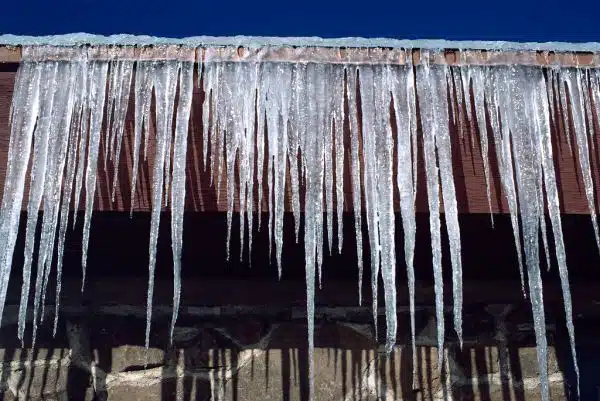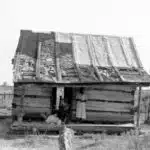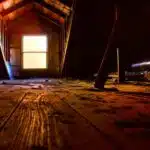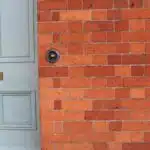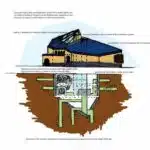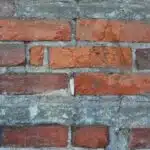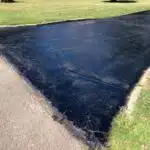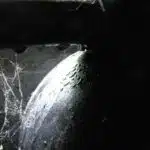Ice dams are a common problem among homeowners who live in areas with heavy snowfall and cold temperatures. These dams can damage the roof, cause water leaks and even pose a threat to the safety of people living in the house. As a roofing specialist, I have seen many cases where ice dams have caused extensive damage to homes, leading to costly repairs. In this article, I will provide you with some tips on how to get rid of and prevent ice dams so that you can protect your home from this winter hazard.
To start, it’s important to understand what causes ice dams in the first place. Ice dams occur when snow on the roof melts due to heat escaping from the house or from direct sunlight. The melting snow then flows down the roof until it reaches a colder area, usually at the edge of the roof or gutters, where it refreezes into ice. As more snow melts and freezes, this ice dam grows larger and thicker until it blocks water from draining off the roof. This can cause water to back up under shingles or into your home, causing serious damage. Now that we know what causes ice dams, let’s look at how we can prevent them from forming in the first place.
Understanding The Causes Of Ice Dams
Culprits behind costly concerns: Causes of ice dams. These pesky ice formations that cling to the edges of roofs are more than just a nuisance; they can cause serious damage to your home. Ice dams typically occur when heat from inside the house rises to the attic, warming up the roof and melting snow. The melted water then runs down the roof, refreezing when it reaches the colder eaves, creating an ice dam.
The icicles that form along the edge of your roof may look pretty but don’t be fooled; they’re a clear sign of trouble. Ice dams can wreak havoc on your home’s exterior and interior if left unaddressed. Prevention techniques should be taken seriously to avoid damage to your home. One effective prevention method is to ensure proper insulation and ventilation in your attic, which will help keep heat from escaping and prevent snow from melting on your roof.
Another way to prevent ice dams is by removing snow from your roof after every big storm. This method requires careful consideration as it might not be safe for inexperienced homeowners or require professional assistance. Regardless, taking this proactive measure can go a long way in preventing ice dams from forming and causing significant damage to your home’s infrastructure.
Recognizing The Signs Of Ice Dams
Identifying warning signs is crucial to preventing ice dams from forming or growing on your roof. The first sign of an ice dam is icicles hanging from the roof’s edge, which indicates that water is freezing and accumulating instead of draining off. Other warning signs include water stains or drips on the interior walls or ceiling, warped shingles, and visible damage to the gutters.
If you notice any of these warning signs, it is essential to seek professional advice immediately. Ice dams can cause significant damage to your roof, gutters, and attic insulation if left unresolved. A roofing specialist or ice dam prevention expert can assess the situation and provide tailored advice on how to prevent further damage.
Ignoring the warning signs of ice dams can lead to expensive repairs down the road. It’s vital to take action as soon as possible by seeking professional advice and implementing preventive measures. In the next section, we’ll discuss how to safely remove existing ice dams from your roof without causing additional damage.
Removing Ice Dams Safely
As winter approaches, it is essential to take necessary precautions to avoid potential hazards caused by ice dams. Ice dams can cause serious damage to roofs, leading to leaks, rotting and mold growth in homes. Removing ice dams safely is a crucial step towards preventing such damages while ensuring the safety of homeowners.
Safety precautions should be taken before attempting to remove ice dams. Firstly, homeowners should ensure that they have proper gear such as gloves, slip-resistant boots and a helmet. Additionally, they should secure a ladder on sturdy ground and make sure it extends three feet beyond the roofline. Homeowners must also ensure that they do not climb onto the roof with sharp tools that could puncture their roofing materials.
DIY vs professional removal is also an important factor to consider when removing ice dams. While DIY methods may seem like a cost-effective option, it comes with risks that may lead to further damage or injury. Professional removal ensures safe and efficient removal of ice dams without damaging roofing materials or risking accidents. Homeowners should carefully weigh these options before deciding on what method works best for them.
To conclude this section, removing ice dams safely requires proper equipment and safety measures in place. Homeowners are advised to consider hiring professionals for safe and efficient removal of ice dams. In the next section, we will discuss using roof rakes as an effective way of preventing ice dam formation on your roof during winter months.
Using Roof Rakes To Prevent Ice Dams
Roof rakes are an effective way to prevent ice dams from forming on your roof. They come in various shapes and sizes, and they work by removing snow from the edge of your roof before it has a chance to turn into ice. Using a roof rake can be more cost-effective than hiring a professional company to remove the ice dams for you.
Roof Rake Benefits include their versatility, affordability, and effectiveness. They are versatile because they can be used on different types of roofs, including shingle, metal, and flat roofs. They are also affordable because they can be purchased for less than $100 at most hardware stores. The effectiveness of roof rakes lies in their ability to remove snow before it turns into ice. By removing the snow from the edge of your roof, you prevent it from becoming trapped behind an ice dam.
Choosing the Right Roof Rake is essential for preventing ice dams effectively. Look for a rake that is long enough to reach the edge of your roof comfortably. It should also have a comfortable grip that won’t slip out of your hands when you’re using it. Additionally, consider if you want a rake with wheels or not. Rakes with wheels make it easier to move across your roof without damaging shingles or other roofing materials.
Using a roof rake is an effective method for preventing ice dams on your roof. However, if you’re looking for a more permanent solution or live in an area with particularly harsh winters, installing heat cables may be necessary. Heat cables work by melting the snow and ice as it forms on your roof’s edge, preventing it from turning into an ice dam over time.
Installing Heat Cables To Prevent Ice Dams
Did you know that installing heat cables can prevent ice dams from forming on your roof? In fact, a study conducted by the Insurance Institute for Business and Home Safety found that homes with properly installed heat cables had significantly fewer ice dams compared to those without. This makes investing in heat cables a smart choice for homeowners living in areas prone to heavy snowfall.
When it comes to choosing the right heat cable option, there are several factors to consider. Firstly, costs vary depending on the type of cable and length needed for your roof. Some options may be more expensive upfront but have higher energy efficiency ratings, leading to long-term savings on electricity bills. Secondly, effectiveness also varies between different types of cables. It’s important to research and compare the features of each option before making a decision.
Another consideration is whether to attempt a DIY installation or hire a professional. While DIY may seem like a cheaper option, it can be risky without proper knowledge and experience. A professional installation ensures that the job is done correctly and safely, reducing the risk of accidents or damage to your roof.
- Factors to consider when choosing heat cables:
- Types of cable available
- Length needed for your roof
- Costs (upfront vs long-term)
- Energy efficiency ratings
- Effectiveness in preventing ice dams
Incorporating heat cables into your roofing system is an effective way to prevent ice dams from forming. By considering factors such as costs, effectiveness, and DIY vs professional installation, you can make an informed decision about which option is best suited for your needs. Once these steps are taken care of, sealing air leaks should be the next step towards ensuring maximum efficiency in preventing ice dams from forming on your roof.
Sealing Air Leaks To Prevent Heat Loss
The first step in preventing ice dams from forming is to identify any air leaks in the building envelope. These air leaks can be found along the roofline, walls, windows, doors, and other areas where air can escape. Sealing these air leaks is an important part of preventing heat loss and thus preventing ice dams from forming. Caulking and spray foam are two of the most common methods of sealing air leaks. Weatherstripping is also a great way to seal air leaks by eliminating gaps between the door or window and its frame. In addition to sealing air leaks, installing insulation and proper ventilation can also help to prevent heat loss and the formation of ice dams.
Identifying Air Leaks
Detecting leaks is the first step in preventing heat loss and ice dams from forming on your roof. It is important to identify air leaks early to prevent further damage that could be costly to repair. One way to detect leaks is by conducting a thorough inspection of your attic or crawl space. Look for gaps around vents, pipes, and wiring that lead outside. You can use a flashlight to check for light coming through these areas or feel for cold spots using your hand.
Once you have detected leaks, it is time to seal them up. Sealing gaps and cracks around windows and doors can help reduce energy waste and improve the overall comfort of your home. You can use caulking or weatherstripping to fill gaps around windows and doors. Another effective method is using spray foam insulation to fill larger gaps around plumbing fixtures, electrical wires, and other areas where air might be escaping.
Preventing heat loss by sealing air leaks not only helps keep your home warm during the winter months but also reduces the chances of ice dams forming on your roof. By detecting leaks early and sealing them up, you can save money on energy bills while protecting your home from potential water damage caused by ice dams. Regularly checking for air leaks and taking preventative measures will keep your roof in top condition for years to come.
Sealing Air Leaks
Sealing air leaks is an essential task in preventing heat loss and ice dams from forming on your roof. By minimizing the amount of air that escapes your home, you can reduce energy waste and improve the overall comfort of your living space. Air sealing benefits go beyond just saving money on energy bills; it also helps prevent mold growth, improves indoor air quality, and enhances the durability of your home.
There are various DIY air sealing techniques homeowners can use to seal gaps and cracks around windows, doors, vents, and other areas where air might be escaping. Caulking or weatherstripping can be used to fill small gaps around windows and doors, while spray foam insulation is ideal for filling larger gaps around plumbing fixtures, electrical wires, and other penetrations. Properly sealing these areas will help create a more airtight home envelope that prevents unwanted heat transfer and moisture infiltration.
It’s essential to note that air sealing is not a one-time task but rather an ongoing process that requires regular maintenance. As such, homeowners should evaluate their homes’ airtightness regularly and make necessary repairs promptly. A professional roofing specialist or ice dam prevention expert can conduct an energy audit to identify potential leaks and provide recommendations for proper air sealing techniques suited for your home’s unique needs.
Weatherstripping
To further prevent heat loss and reduce energy waste, homeowners can opt for DIY weatherstripping techniques. Weatherstripping involves sealing the gaps around windows and doors to create an airtight seal that prevents drafts from entering the home. There are various types of weatherstripping materials available in the market today, including adhesive-backed foam tape, V-strip, door sweeps, and more. These materials are easy to install and can be cut to fit any size or shape of window or door.
While DIY weatherstripping can be effective in sealing air leaks, hiring professionals for weatherstripping is still recommended for optimal results. Professional roofing specialists or ice dam prevention experts have the necessary tools and expertise to identify potential leaks and recommend the best weatherstripping materials suited for your home’s unique needs. Additionally, professional installation ensures that all areas are sealed correctly, providing maximum protection against heat loss and drafts.
In conclusion, weatherstripping is a cost-effective way of reducing energy bills while improving indoor comfort levels. Whether you choose to do it yourself or hire professionals for the task, it’s essential to make sure that all areas around windows and doors are sealed correctly. By doing so, you can prevent heat loss and improve your home’s energy efficiency without sacrificing comfort levels.
Adding Insulation To Your Attic
Insulating your attic is an effective way to prevent ice dams from occurring. The benefits of insulation go beyond just preventing ice dams, as it also helps regulate the temperature in your home and can save you money on energy bills. There are various types of insulation to choose from, such as fiberglass, cellulose, and spray foam.
Fiberglass insulation is a popular choice due to its affordability and effectiveness. It comes in batts or rolls that can be easily installed between joists in your attic. Cellulose insulation is made from recycled materials and provides excellent coverage when blown into the attic. Spray foam insulation is more expensive but offers superior performance by sealing gaps and cracks that other types may miss.
When choosing insulation for your attic, it’s important to consider factors such as R-value (the measure of thermal resistance), moisture resistance, and fire safety. Consulting with a roofing specialist or ice dam prevention expert can provide valuable insight into which type of insulation would be best for your specific situation.
Properly insulating your attic is one step towards preventing ice dams, but it’s not enough on its own. In our next section, we’ll discuss how properly ventilating your attic can work together with insulation to keep your roof free from ice dams.
Properly Ventilating Your Attic
Installing vents is an important part of properly ventilating any attic space. The size and number of vents needed for a particular attic should be calculated based on its size and the local climate. It is also important to check for and seal any air leaks that may exist in the attic. Air leaks can be a contributing factor to ice dam formation on roofs, so they should be addressed in order to prevent this issue. Properly installed vents will allow for the adequate exchange of air in the attic. This helps to prevent condensation and the formation of ice dams. In summary, proper vent installation and sealing of air leaks are important steps in preventing ice dams and maintaining a healthy attic environment.
Installing Vents
To properly ventilate your attic, installing vents is crucial. Installing vents can help prevent the formation of ice dams on your roof by allowing warm air to escape from the attic space. There are various ventilation options for homeowners, including soffit vents, ridge vents, gable vents, and turbine vents. Consult with a roofing specialist or ice dam prevention expert to determine which ventilation option is best for your specific home.
Installing soffit vents is an effective way to increase ventilation in your attic. Soffit vents are installed underneath the eaves of the roof and allow cool air to enter the attic space. This cool air replaces warm air that rises and exits through other venting options such as ridge or gable vents. It’s important to ensure that there are enough soffit vents installed to provide adequate airflow in your attic.
In addition to soffit vents, installing ridge vents can also aid in proper attic ventilation. Ridge vents are installed along the peak of the roof and allow warm air to escape from the attic space. This creates a continuous flow of air throughout the entire attic space, preventing hot spots that can lead to ice dam formation. Consider consulting with a roofing specialist or ice dam prevention expert for advice on vent installation and proper ventilation techniques for your specific home.
Calculating Ventilation Requirements
To ensure proper attic ventilation, it’s essential to calculate the necessary amount of ventilation for your home. The amount of ventilation required depends on several factors, including the size and shape of your attic space, the type of roof you have, and the climate in which you live. It’s important to note that inadequate ventilation can lead to numerous problems such as mold growth and ice dam formation. Therefore, it is recommended that homeowners consult with a roofing specialist or ice dam prevention expert to calculate their specific ventilation requirements.
Once you’ve determined your home’s ventilation requirements, the next step is proper installation. Proper installation is key to ensuring that your vents function as they should. Improperly installed vents can lead to air leaks or gaps in insulation, which can compromise your home’s energy efficiency and increase the likelihood of ice dam formation. To maximize efficiency, it’s crucial to install vents in a way that creates a balanced airflow throughout the attic space.
In conclusion, calculating ventilation requirements and proper installation are crucial aspects of properly ventilating your attic. Homeowners should seek professional advice from roofing specialists or ice dam prevention experts to ensure that their homes meet proper ventilation standards. Adequate ventilation not only helps prevent ice dams but also improves energy efficiency and prolongs the lifespan of your roof.
Sealing Air Leaks
Properly ventilating your attic is essential to prevent ice dams and improve energy efficiency. However, it’s equally important to seal air leaks in your attic. Air leaks can compromise the effectiveness of your insulation, leading to energy loss and increased heating or cooling costs. While some homeowners may attempt DIY sealing, it’s highly recommended that a professional roofing specialist or ice dam prevention expert be consulted for proper sealing.
Professional sealing can ensure that all potential air leaks are identified and properly sealed off. This not only prevents ice dams but also improves indoor air quality by reducing the infiltration of outdoor pollutants and allergens. Additionally, proper sealing can prolong the lifespan of your roof by preventing moisture buildup in the attic space.
In conclusion, while proper ventilation is crucial for attic health, sealing air leaks should not be overlooked. Consulting with a professional roofing specialist or ice dam prevention expert will ensure that all potential air leaks are identified and sealed off correctly. The benefits of sealing go beyond ice dam prevention and include improved energy efficiency, indoor air quality, and an extended roof lifespan.
Cleaning Gutters And Downspouts
Gutters and downspouts are like the veins of your house. They carry rainwater and snowmelt away from your roof, walls, and foundation. But when they get clogged with debris, leaves, or ice, water can back up and cause all sorts of problems. The weight of water can damage your gutter system, create leaks in your roof, or even cause the gutters to detach from the house. That’s why it’s crucial to keep them clean and free-flowing.
The importance of frequency cannot be overstated when it comes to gutter maintenance. Depending on where you live and how many trees surround your property, you may need to clean your gutters every season or twice a year. Fall is usually the busiest time because the leaves fall off the trees and clog up the gutters. Winter can also be challenging if you have ice dams forming in your eaves or valleys. Spring is a good time to inspect for any damage caused by winter storms, while summer is an opportunity to check for loose brackets or leaky seams.
When it comes to cleaning gutters and downspouts, you have two options: DIY or professional services. DIY can save you money but requires some physical effort and risk-taking if you’re not comfortable working at heights or using power tools. You’ll need a sturdy ladder, gloves, scoop or trowel, garden hose or pressure washer (with adjustable nozzle), safety glasses or goggles, and maybe a bucket to collect debris. Professional services offer convenience and expertise but come with a price tag that varies depending on the scope of work needed. They may use special equipment like gutter vacuums that suck out all debris without leaving a mess on your lawn or roof.
Regular cleaning of gutters and downspouts will help prevent ice dams from forming on your roof during winter months; however there are still other measures that must be taken as well such as removing snow from your roof.
Removing Snow From Your Roof
After cleaning the gutters and downspouts, the next step to preventing ice dams is removing snow from your roof. Snow buildup on your roof can lead to ice dams, which can cause significant damage if not addressed promptly. Preventing leaks is crucial in maintaining the longevity and safety of your home, so it’s essential to remove any excess snow as soon as possible.
There are several snow removal techniques that you can utilize to prevent ice dams. One of the most effective methods is using a roof rake to remove snow from your roof. A roof rake allows you to remove snow without damaging your shingles or other roofing materials. Additionally, you can use calcium chloride tablets to melt any remaining ice dams safely.
However, removing ice dams can be dangerous and challenging work, especially if you’re not experienced in doing so. It’s best to hire a professional who has the necessary equipment and expertise to remove ice dams safely and effectively. A professional will ensure that all ice dams are removed and will also take steps to prevent them from forming again in the future. Don’t hesitate to contact a professional if you’re experiencing issues with ice dams on your property – prevention is key when it comes to maintaining the integrity of your home’s roofing system.
Hiring A Professional To Remove Ice Dams
Hiring professionals is an option for homeowners who want to remove ice dams safely and efficiently. While it may cost more than a DIY approach, hiring experts can ensure that the job is done correctly and without causing damage to the roof or other parts of the house. Moreover, professionals have access to specialized equipment such as steamers, which are effective in removing ice dams without damaging the shingles.
When considering the cost effectiveness of hiring professionals, it is important to weigh the potential costs of not doing so. Ice dams can cause significant damage to a home’s interior and exterior if left untreated. For example, water leakage from melting ice can lead to mold growth, structural damage, and expensive repairs. Therefore, investing in professional removal services can save homeowners money in the long run by preventing these issues from arising.
In addition to removing existing ice dams, professionals can also provide preventative measures to minimize their likelihood of forming in the future. These measures may include adding insulation or ventilation systems to attics or applying deicing agents to roofs. By taking proactive steps with the help of professionals, homeowners can prevent ice dams from forming and avoid costly damages altogether.
As a homeowner looking for solutions on how to get rid of and prevent ice dams, hiring professionals may be an effective option worth considering. Not only do experts have access to specialized equipment and knowledge on how best to remove ice dams safely and efficiently, but they can also provide preventative measures that save homeowners money in the long run. In the next section, we will discuss using deicing agents as another method for preventing ice dams from forming on your roof.
Using Deicing Agents
Deicing agents can be an effective solution to prevent and remove ice dams. The most common deicing agents include calcium chloride, sodium chloride, and potassium chloride. These agents work by lowering the freezing point of water, which helps to melt ice and snow. Calcium chloride is the most effective agent as it can melt ice at much lower temperatures than other options.
While deicing agents are effective in preventing ice dams, it is important to note that some options may not be environmentally friendly. Sodium chloride, for example, can harm vegetation and groundwater systems. Therefore, homeowners should consider using more environmentally friendly options such as potassium chloride or magnesium chloride. These options are less harmful to the environment while still providing good results.
It is important to remember that deicing agents should be used sparingly and only when necessary. Overuse of these chemicals can lead to damage to roofing materials and cause harm to the environment around your home. Regular maintenance of your roof can also help prevent the need for excessive deicing agent use. In the next section, we will discuss how proper maintenance techniques can help prolong the life of your roof and prevent ice dams from forming in the first place.
Maintaining Your Roof
Roof maintenance is essential for preventing ice dams and other common roof problems. Regular inspections and upkeep can help prolong the life of your roof and prevent costly repairs. Here are some roof maintenance tips to help you keep your roof in good condition.
Firstly, remove debris such as leaves or twigs from your roof on a regular basis. This debris can trap moisture and cause water damage to your roof, leading to the formation of ice dams. Secondly, ensure that your gutters and downspouts are clear of any blockages that may prevent proper water drainage. Poor drainage can also lead to water damage and ice dam formation.
Thirdly, check for any signs of wear and tear on your shingles or other roofing materials. If you notice any cracks or missing pieces, it is important to have them repaired as soon as possible. Damaged shingles can allow water to seep through, which can lead to further damage such as rotting wood or mold growth.
Lastly, consider hiring a professional roofing contractor for an annual inspection. They will be able to identify potential issues before they become major problems and provide recommendations for necessary repairs or maintenance.
By following these simple roof maintenance tips, you can prevent common roof problems such as ice dams and prolong the life of your roof. In the next section, we will discuss repairing any roof damage that may already exist.
Repairing Any Roof Damage
After experiencing the frustration of dealing with ice dams, homeowners may be left with roof damage. It is important to repair any damages as soon as possible to prevent further complications. Repairing damages caused by ice dams can be a costly endeavor, but it is necessary to ensure the longevity of your roof and prevent future issues.
To begin repairing any roof damage, it is important to first assess the extent of the damage. This can be done by visually inspecting your roof or hiring a professional roofing specialist to conduct a thorough inspection. Once the damage has been assessed, an estimate for repairs can then be made. The cost estimation will vary depending on the severity of the damage and the materials needed for repairs.
It is crucial to hire a reputable and experienced contractor for any necessary repairs. A poorly done repair job can result in further complications and even more expenses down the line. By taking proper care in repairing damages caused by ice dams, homeowners can have peace of mind knowing that their roof is secure and protected against future issues. In the next section, we will discuss how to stay safe while dealing with ice dams.
Staying Safe While Dealing With Ice Dams
After repairing any roof damage, it is important to take necessary measures to prevent the formation of ice dams. One of the most effective ways to prevent ice dams is by ensuring proper insulation and ventilation in the attic. This helps to maintain a consistent temperature on the roof, preventing snow from melting and refreezing at the eaves.
Another way to prevent ice dams is by using heat cables or tapes. These can be installed along the eaves and gutters to melt snow as it accumulates, preventing it from turning into ice. However, caution must be taken when installing these cables as they can pose a fire hazard if not properly installed.
Staying safe while dealing with ice dams involves preventing falls and using protective gear. When removing snow or ice from your roof, it is important to use a sturdy ladder that is secured against the house. It is also recommended that you wear slip-resistant shoes with good traction and use a safety harness for added protection. Protective eyewear should also be worn to protect your eyes from falling debris. By taking necessary precautions, you can prevent accidents and safely deal with ice dams without causing harm to yourself or others.
Conclusion
Ice dams can cause significant damage to your roof and can be dangerous to remove. Understanding the causes and recognizing the signs of ice dams is crucial in preventing them from occurring. Removing ice dams safely requires caution and proper equipment, such as a roof rake or heat cables.
Preventing ice dams involves regular maintenance of your roof, including repairing any damage and using deicing agents when necessary. As a roofing specialist or ice dam prevention expert, it is important to stress the importance of staying safe while dealing with these potentially hazardous situations.
In conclusion, preventing and removing ice dams requires knowledge, preparation, and caution. Like a skilled surgeon carefully removing a tumor, one must approach the task with precision and care to prevent further damage. By understanding the causes and recognizing the signs of ice dams, maintaining your roof, and staying safe while removing them, you can protect your home from costly damages caused by these icy intruders.
Image Credits
- “Ice dam” by State Farm (featured)

